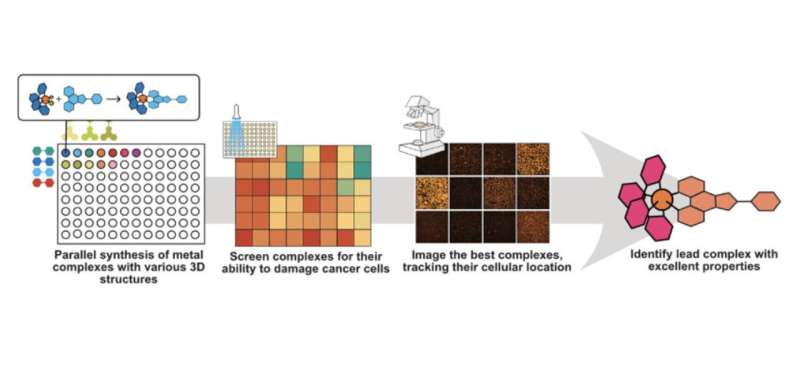This article has been reviewed according to Science X's editorial process and policies. Editors have highlighted the following attributes while ensuring the content's credibility:
fact-checked
peer-reviewed publication
trusted source
proofread
New synthesis platform allows for rapid cancer drug synthesis and testing

Imperial College London researchers have developed a new platform for the synthesis, analysis and testing of new compounds which may one day treat cancer. The findings are published in the journal Angewandte Chemie International Edition.
The discovery of new compounds with pharmacological properties can be expensive and time-consuming. Therefore, there is an increasing interest in developing workflows that allow for the rapid synthesis and testing of multiple compounds in parallel.
Imperial scientists, Professor Ramon Vilar and Dr. Tim Kench from the Department of Chemistry, have developed a workflow that focuses on metal-based compounds that become highly toxic to cancer cells upon exposure to light.
Using this light-activated toxicity to kill cancerous cells is known as photodynamic therapy (PDT).
First, the researchers synthesized a large collection of iridium-based compounds. Attaching different molecular fragments to a central iridium core allowed the researchers to manipulate the structure and properties of different compounds.
The team then studied the performance of these metal complexes using a series of semi-automated tests, looking at how well they could damage cancer cells and what parts of the cell they targeted.
Dr. Kench said, "The aim of this platform is to take simple building blocks and rapidly generate a diverse set of compounds with different properties. By combining this approach with automation, you increase the efficiency and speed of the discovery of potential new diagnostic and therapeutic compounds."
Iridium for photodynamic therapy
Metal-based compounds have been recognized for their broad range of properties which can be advantageous in the development of drugs.
Prof Vilar said, "We looked specifically at iridium complexes due to their unique properties that make them well-suited for photodynamic therapy."
"For an agent to be effective for photodynamic therapy, it should be completely non-toxic in the dark, but also very toxic once activated by light," Dr. Kench said. "As opposed to traditional chemotherapy drugs, this approach potentially allows us to have a high degree of control over exactly where we damage the cells, hopefully reducing side effects."
However, the process of synthesizing new photo-toxic compounds with the ideal set of properties for anticancer agents can be a difficult process.
"It can be very hard to predict and balance the different characteristics of new compounds, such as their chemical stability, how they respond to light and their cellular uptake," said Professor Vilar, showing how their platform tackles these challenges.
Automation and computer modeling
The new approach uses 'combinatorial synthesis' where different simple molecules were attached to an iridium center.
The platform allows researchers to assemble the fragments onto the metal core in 3D space, almost like attaching blocks of Lego.
These compounds can be generated without any side products, meaning that they can then be tested using automated chemical and biological assays without the need for time-costly purification.
Using their platform, the authors made and tested a library of 72 complexes at the same time, investigating factors including how well each complex could generate reactive oxygen species, each complex's tolerability in the dark, and its efficiency when killing cancer cells exposed to light.
They then used the information to design a second-generation library of 18 compounds that displayed even better anticancer properties. By using liquid handling robots to assist with the synthesis and testing, they were able to shorten this entire synthesize-and-test cycle to three days. In comparison, conventional synthesis and test methods can take several weeks for libraries this size.
To understand why some complexes were better than others, the researchers collaborated with a team at the Massachusetts Institute of Technology, led by Professor Heather Kulik, who specializes in computational analysis and machine learning applications.
Using computational techniques, the research team were able to analyze key electronic parameters of the compounds and correlate them with experimental data.
The team said that the next steps for their platform would be to expand the existing library of compounds and data, and to integrate machine learning models that can find patterns between high-performing compounds. Models can then suggest the synthesis of new libraries of novel candidate compounds.
More information: Timothy Kench et al, A Semi‐Automated, High‐Throughput Approach for the Synthesis and Identification of Highly Photo‐Cytotoxic Iridium Complexes, Angewandte Chemie International Edition (2024). DOI: 10.1002/anie.202401808
Journal information: Angewandte Chemie International Edition
Provided by Imperial College London





















